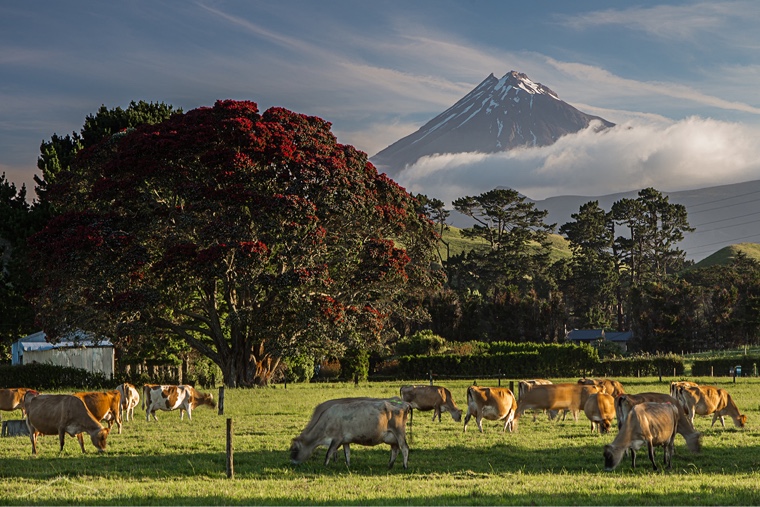Pihama dairy farmers Catherine Stevenson and Simon Walker (no relation to the author) are examples of how the industry is reinventing itself to be not just easier on the environment, but actually good for it.
Regenerative farming is the process of giving back to the land, and making it even healthier, as opposed to being sustainable and keeping it as it currently is. They’re reluctant to label themselves regenerative, but are on a journey of figuring out how to increase their resilience by boosting soil health as much as possible.
In the last 12 months, they’ve dropped their use of the herbicide glyphosate by 90% and have turned to a natural soil booster called fish hydrolysate. They’ve dropped their stock numbers by around 60 to be running 500 dairy cows, and are constantly reviewing their stock rotation and cropping. They’ve also started aerating their soil much more.
The aim is to enable the grass and soil to hold moisture and nutrients better, and early results are positive.
Despite the drop in stock numbers, the financial performance of the farm has actually improved.
“From a production perspective, we’re on target to have about the same as we did with 560 cows, if not more,” they say. “We’ve also dropped about 60 cents per kg of milk solids in costs, which is about 15%. Because it’s been a great season, that transition has happened a lot faster than if it was a drought year, but we’re sold on what we’re doing and we’re not going back.”
They’ve also dropped their use of synthetic nitrogen fertilisers from 220kgs per hectare to 45kgs — well below the new government cap of 190kgs — and are now trying to get down to zero. That essentially means 75% fewer nitrates in the ground and waterways.
On top of that, they’re seeing the benefits for their cows too. They say they’ve had much less mastitis, and they’ve only had around 10 lame cows since mid-January. A year ago they’d had 60 at this stage, and with the rain they’ve had this year, it’s likely that figure would have been higher than usual.
“The cows are looking like racehorses. They’ve got veins popping, shiny coats and they’re just looking amazing.”
The pair farm in conjunction with Stevenson’s parents, and her father, Michael, has been on the land for the past 50 years. He says it will probably take 3-4 years to see the full effects of what they’re doing in the soil, but he’s encouraged by what he’s seeing so far.
“It’s hard to measure success at this stage, but we’re seeing good worm activity, the clover looks good and the cows are content. That’s a really good indicator.”
The farm is one of 20 farm enterprises participating in a local initiative to support trials and transitions into regenerative farming in Taranaki. Taranaki Regenerative Agriculture’s Fiona Young says well over 100 farmers have been in touch with her and are keen to learn more about what regenerative farming involves.
“The most significant change for some farmers is their mindset,” she says. “Rather than pushing for high production and often a more extractive approach, the focus becomes more centred on working with and as part of nature and natural systems.
“Its emphasis is more on profit than production and overall health and resilience. This is achieved by relating to the farm as a living ecosystem that requires soil health and biodiversity to come into focus and be prioritised, along with farmers’ personal wellbeing.”
“Taranaki has an incredible potential and unique advantages to nourish and look after our local people, animals and environment through this integrated whole system approach. It can only be a good thing for Taranaki – it wouldn’t be regenerative otherwise!”
Federated Farmers Taranaki President Mark Hooper believes this type of farming is not only good for production, but it taps into a lucrative market of quality products that are certified as responsible and ethical.
He sees Fonterra’s Co-operative Difference Payment as a vehicle that can promote and encourage that even further.
Under the scheme, which comes into effect in June, Fonterra will pay farmers up to 10 cents per kilogram of milk solids if they meet on-farm sustainability and value targets. These metrics include proportion of home grown feed used, animal care plans, effluent disposal, riparian planting and other measures.
Hooper believes incentivising quality, responsible production means New Zealand foods can be sold to big international companies that want to show they’re using the very best.
“Take a big customer like Nestle for example. They want to be able to tell consumers they’re getting towards zero carbon from what they’re producing, that they’re supporting things like animal welfare and good labour relationships. They can do that by purchasing New Zealand dairy products that are certified in all these ways.”
The farm is one of 20 farm enterprises participating in a local initiative to support trials and transitions into regenerative farming in Taranaki. Taranaki Regenerative Agriculture’s Fiona Young says well over 100 farmers have been in touch with her and are keen to learn more about what regenerative farming involves.
“The most significant change for some farmers is their mindset,” she says. “Rather than pushing for high production and often a more extractive approach, the focus becomes more centred on working with and as part of nature and natural systems.
“Its emphasis is more on profit than production and overall health and resilience. This is achieved by relating to the farm as a living ecosystem that requires soil health and biodiversity to come into focus and be prioritised, along with farmers’ personal wellbeing.”
“Taranaki has an incredible potential and unique advantages to nourish and look after our local people, animals and environment through this integrated whole system approach. It can only be a good thing for Taranaki – it wouldn’t be regenerative otherwise!”
